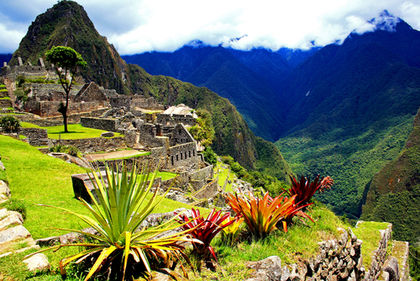Peru - Famous peruvians

The Inca Huayna Capac (1450?–1525) reigned from 1487 and extended the Inca Empire, encouraging public works and fine arts. On his death he left the empire to his two sons, Huáscar (1495?–1533) and Atahualpa (1500?–1533); Huáscar was executed by his half-brother, and Atahualpa, the last of the great Incas, was executed by the Spanish conquistador Francisco Pizarro (1470?–1541). Acknowledged as America's first great writer, Garcilaso de la Vega (El Inca, 1539?–1616), son of a Spanish conquistador and an Inca princess, preserved in his Royal Commentaries of the Incas authentic descriptions of this ancestral empire and its traditions. Manuel de Amat (fl.18th century), viceroy from 1762 to 1776, was a patron of the colonial theater and of the famous actress Micaela Villegas, known as La Perricholi. Tupac Amaru II (José Gabriel Condorcanqui, 1742–81), partly descended from the Incas, led a revolt against Spanish rule in 1780 in which he was defeated, captured, and executed.
Dr. José Hipólito Unnúe (1758–1833), a statesman and scientist, founded Lima's medical school in 1808 and reformed Peruvian education. The hero of the War of Independence, Mariano Melgar (1792–1815), was also a poet and composer whose regional songs (yaravís) are still popular. Marshal Ramón Castilla (1797–1867) distinguished himself in two great presidential terms (1845–51, 1855–62), introducing railways and the telegraph, emancipating the slaves, abolishing Amerindian tribute, modernizing Lima, and developing the important guano industry. Ricardo Palma (1833–1919) is considered Peru's greatest literary figure; a critic, historian, and storyteller, he originated the genre called tradición, and wrote the 10-volume Tradiciones Peruanas. José María Valle-Riestra (1858–1925) was an important composer.
In the modern era, the work of an erudite Amerindian, Julio Tello (1880–1947), became internationally known in archaeological circles. Jorge Chávez (1887–1910) made the first solo flight across the Alps in 1910. Santos Chocano (1875–1934), César Vallejo (1895–1938), and José María Eguren (1882–1942) are considered Peru's finest modern poets. Established prose writers are Víctor Andrés Belaúnde (1883–1966), Jorge Basadre (1903–80), and Ciro Alegría (1909–67); the novelist Mario Vargas Llosa (b.1936) was the first Latin American president of PEN, an international writers' organization. Peru's best-known contemporary painter is Fernando de Szyszlo (b.1925). Other noted Peruvians include Ventura García Calderón (1866–1959), a writer; José Sabogal (1888–1956), a painter; Honorio Delgado (1892–1969), a scientist; and José Carlos Mariátegui (1895–1930), a political essayist. Yma Sumac (b.1928) is an internationally known singer.
Víctor Raúl Haya de la Torre (1895–1979) originated APRA in 1924 as a Latin American workers' movement; it became Peru's most significant political force. Gen. Juan Velasco Alvarado (1910–77), who led the military coup of 1968, ruled as president of Peru until his own ouster by a bloodless coup in 1975. Gen. Francisco Morales Bermúdez Cerruti (b. 1921), president during 1975–80, prepared the country for a return to civilian rule. Fernando Belaúnde Terry (1913–2002), founder of the Popular Action Party, served as president during 1963–68 and again during 1980–85. Alán García Pérez (b. 1949) was elected president in 1985. In 1982, Javier Pérez de Cuéllar (b. 1920) became secretary-general of the UN.